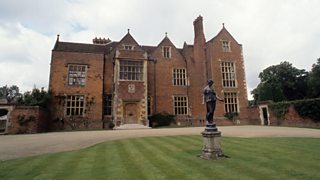The date 8 January might not strike an immediate chord with most people but on that day in 1921 the British government, in the shape of its prime minister, David Lloyd George, took possession of an English country house that has since become synonymous with the premiership.
Since 1921 Chequers – or Chequers Court as it is more properly known – has been the country retreat of every prime minister who has governed the country. It all began with that diminutive Welsh wizard, Lloyd George, the only Welshman (so far, at least) to rise to the position of Britain's leading politician.

Chequers
Lloyd George was actually born in Manchester but grew up in Caernarvonshire and was Welsh through and through. After qualifying as a solicitor, he entered parliament in April 1896 and quickly rose to become president of the board of trade and, in 1908, chancellor of the exchequer. He held this post until becoming prime minister, first of the coalition wartime government in 1916 and then, once peace returned, of the last ever Liberal administration.
It was a position and a role that Lloyd George maintained until 1922. During that time he guided Britain to victory in the Great War, oversaw the 1919 peace treaties at Versailles and was still in power when the war in Ireland was brought to some kind of respite by the partition of that troubled land. It was certainly a period of intense stress and strain for the prime minister, and that was where Chequers came in.
Situated just south of Aylesbury in Buckinghamshire, in the foothills of the Chilterns, there had been a house on the Chequers site since the 12th century. The origin of the name is a little unclear but it may well have come from the first owner, a man called Ostiarius who was an usher at the Court of the Exchequer.
Over the years the house passed through many hands and was extensively re-built several times. At one stage it was home – perhaps prison might be a better word? - to Lady Mary Grey, the sister of Lady Jane Grey who was briefly installed as queen for 13 days before public opinion restored Mary Tudor, the rightful monarch, to the throne. Lady Mary lived at the house for two years and the bedroom where she slept is still there.
Chequers also had strong connections to Oliver Cromwell and his family. Several items of Cromwell memorabilia are still kept at the house.
Eventually the house ended up in the ownership of a Mr Arthur and Mrs Ruth Lee. Mrs Lee was an American who had strong views about the place; she stripped out the Gothic style furnishings and fittings and restored the house to a mock-Tudor facade.
During World War One Chequers was used as a hospital and convalescent home for officers and by 1917 Arthur and Ruth Lee already had plans to move elsewhere. The question of what to do with Chequers remained.
Significantly, all prime ministers in the pre-war era had come from the landed gentry or, at the very least, from families with money. There was no problem for them to find quiet or secluded houses where they could get away, for a few days or, sometimes, a few weeks, from the rush and crush of government.
By 1919, however, it was clear that politics was changing and that the type of men – the thought of a woman prime minister was then far from anyone's mind – who were likely to be leading the country in the future were very different from their earlier counterparts. They would not, generally speaking, have a private income and certainly not any form of country retreat. Lloyd George was a typical example.

David Lloyd George
In 1917, after discussions with Lloyd George himself, Arthur and Ruth Lee decided that they would pass on the house at Chequers to the government as a place where prime ministers could relax, unwind and, occasionally, entertain foreign dignitaries. Consequently, the Chequers Act, making everything formal and above board, was passed through parliament that very year.
It took time for Chequers to return to normality after the war and Arthur and Ruth Lee were not finally ready to leave until the end of 1920. So it was only on 8 January 1921 that a formal dinner was held to mark the handing over. The Lees retired from the scene and Lloyd George, as the incumbent prime minister, took possession of Chequers.
Interestingly, Arthur and Ruth Lee had become involved in a political dispute with Lloyd George in the months before the handover. Such spats were not uncommon in Lloyd George's political – and personal - life! But the couple managed to maintain their dignity and the exchange passed off without undue incident.
Since 1921 prime ministers have spent many quiet days at the Buckinghamshire house – only 40 miles away from Downing Street but, to all intents and purposes, light years away - and entertained visitors from all over the world.
It all started with David Lloyd George, arguably the most famous politician Wales has ever produced.